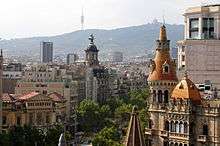Passeig de Gràcia, Barcelona
|
Passeig de Gràcia viewed from Casa Milà | |
| Length | 1.3 km (0.8 mi) |
|---|---|
| Location | Barcelona, Catalonia, Spain |
| Coordinates | 41°23′34″N 02°09′49″E / 41.39278°N 2.16361°ECoordinates: 41°23′34″N 02°09′49″E / 41.39278°N 2.16361°E |
| From | Plaça Catalunya |
| To | Carrer Gran de Gràcia |
Passeig de Gràcia (Catalan pronunciation: [pəˈsɛdʒ də ˈɣɾasiə]) is one of the major avenues in Barcelona (Catalonia) and one of its most important shopping and business areas, containing several of the city's most celebrated pieces of architecture. It is located in the central part of Eixample,[1] stretching from Plaça Catalunya to Carrer Gran de Gràcia.[2]
Passeig de Gràcia is regarded as the most expensive street in Barcelona and in Spain.[3]
History
Formerly known as Camí de Jesús ("Jesus Road"), the Passeig de Gràcia was originally little more than a quasi-rural lane surrounded by gardens joining Barcelona and Gràcia, which was then still a separate town. This was still the case at the time of the first urbanisation project in 1821, which was devised by the liberal city council, and led by Ramon Plana. This project had to be cancelled due to the epidemics that were raging in Barcelona at the time.
After the demise of the liberal government with the return of Absolutism in 1824, the project was taken up again by general José Bernaldo de Quirós, marquis of Campo Sagrado. The new avenue was 42 metres (138 ft) wide in 1827 and became a favourite place for aristocrats to display their horse riding skills and expensive horse-drawn carriages all through the 19th century.
In 1906 the architect Pere Falqués i Urpí designed the avenue's now famous ornate benches and street-lights. By that time it had become Barcelona's most fashionable street, with buildings designed by modernista/Art Nouveau architects of fame such as Antoni Gaudí, Pere Falqués, Josep Puig i Cadafalch, Lluís Domènech i Montaner, Enric Sagnier and Josep Vilaseca.[2]
The government of the Basque Country (Eusko Jaurlaritza) was based in Passeig de Gràcia, 60 during the Spanish Civil War. The Catalan poet Salvador Espriu resided in Casa Fuster (Passeig de Gràcia, 132).
Notable buildings


- Illa de la Discòrdia
- Casa Amatller by Josep Puig i Cadafalch (1890-1900)[2]
- Casa Batlló by Antoni Gaudí (1904-1906)[2]
- Casa Lleó Morera by Lluís Domènech i Montaner (1902-1906)[2]
- Museu del Perfum
- Cases Antoni Rocamora by Josep Bassegoda i Amigó (1914-1917)
- Casa Bonaventura Ferrer by Pere Falqués i Urpí (1906)
- Casa Fuster by Josep Puig i Cadafalch (1908-1911)
- Casa Milà "La Pedrera" by Antoni Gaudí (1905-1910)[2]
- Casa Pons i Pascual by Enric Sagnier (1891)
- Casa Ramon Casas by Antoni Rovira i Rabassa (1898)
- Hotel Majestic (Barcelona) (1918)
- Palau Robert (1903)
- Teatre Tívoli
- Jardins de Salvador Espriu
Transportation
See also
- Eixample, List of streets in Eixample
- Ildefons Cerdà
- Gràcia
- Modernisme, Art Nouveau
- Noucentisme
- Barcelona
Landmark Hotels in Passeig de Gracia
- Hotel Majestic (Barcelona), Catalonia, Spain is a historic, 5-star luxury hotel located on the Passeig de Gràcia in the Eixample district. Opened as a hotel since 1918 and owned by the Soldevila family.
- Hotel Condes de Barcelona
- Hotel SixtyTwo
References
- ↑ Boeing, G. (2016). "Honolulu Rail Transit: International Lessons in Linking Form, Design, and Transportation". Planext. 2: 28–47. Retrieved 2016-04-29.
- 1 2 3 4 5 6 "Passeig de Gràcia". Turisme de Barcelona. Retrieved 2013-12-10.
- ↑ "Ranking de las calles comerciales más caras de españa en 2010" [Ranking of the most expensive shopping streets in Spain in 2010] (in Spanish). idealista.com. Retrieved 2012-07-29.
Bibliography
- ALBAREDA, Joaquim, GUÀRDIA, Manel i altres.Enciclopèdia de Barcelona, Gran Enciclopèdia Catalana, Barcelona, 2006.
External links
- Photo album from Pobles de Catalunya
- Passeig de Gràcia in detail at Gencat.net
- Modernisme in Barcelona - Passeig de Gràcia
- What to visit in the Eixample
- Photo album from Barcelona Tourist Guide
